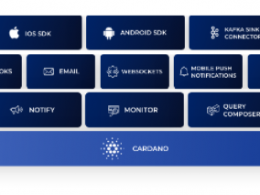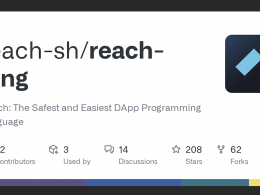Third-generation blockchains such as Cardano, Solana and Polkadot, among others, address scalability in their own way, where interoperability with other networks is part of the theme. The developer community in these ecosystems is growing, driven by mainstream adoption, although as of today, the Ethereum developer community is the largest.
Interoperability can be deployed in different ways, the most widely used is through cross-chain technology, bridges, which seeks the transmission of values and information between different networks, with communication without intermediaries.
Scalability and Interoperability
Achieving scalability and interoperability, as part of it, through a single protocol, is a challenge. The dcSpark team proposes to move forward with sidechain technology to attract both developers and users to Cardano with its new project called Milkomeda.
Future deployments of Milkomeda will open the doors to interoperability between Cardano, Solana and other L1 blockchains. In this way, Milkomeda will work to pursue both the vision of sidechain with the characteristic approach to scalability, as well as the vision of interoperability with multiple blockchains.
Ethereum was the first blockchain to allow programmers to run computations on the network. Milkomeda will help non-EVM (Ethereum Virtual Machine) cryptocurrencies with a seamless UX (User Experience) for developers and users in general.
Milkomeda addresses this by building side-chains with alternative VMs connected to Layer 1 main chains, which use their cryptocurrency as the base asset. In Cardano they will use wADA (wrapped ADA) as the asset to pay transaction fees. It will be a protocol that employs the concept of wrapped smart contracts.
With wrapped smart contracts, the Layer 1 blockchain becomes a robust coordination layer, where users remain while executing smart contracts on the sidechain, without having to switch to the sidechain themselves. This brings a new experience to end users, as they will be able to execute smart contracts on an EVM sidechain directly from the Cardano core network, without having to switch wallets or perform other complex operations.
M1 will be Milkomeda’s first sidechain, and also, Cardano’s first sidechain. Milkomeda validators running the sidechain will be existing pool operators, and other trusted entities within the ecosystem.
“We believe this is an inevitable direction where L1 blockchains, such as Cardano and Solana, have their strong security guarantees that act as a backbone and coordination layer for a diverse ecosystem of many smart contract languages and virtual machines,” said Nicolas Arqueros, CEO of dcSpark.
Charles Hoskinson, CEO of IOHK, stated, “Interoperability is crucial to the widespread adoption of blockchain; at IOHK, we don’t believe there is one blockchain that governs all, but rather we value collaboration. When it comes to interoperability and scalability, sidechains are an essential part of our vision for Cardano. We have pioneered research into Proof of Stake sidechains, and recognize how important they are to interoperability within our industry. Milkomeda is a valuable addition to the Cardano ecosystem, as it will allow developers to benefit from the speed, security and lower costs of Cardano, without the need to switch wallets, or navigate a completely new operating system.“
The Need for Oracles
Oracles are one of the tools blockchain technology uses to interact with the physical world. They are services that bring in and verify real-world information needed to execute a smart contract, with information that can trigger a specific action within the schedule.
The information is gathered from various web platforms to create a consensus, and give an accurate result that cannot be manipulated.
For example, suppose an agricultural insurance smart contract is programmed to transfer value for risk coverage to an insured if certain weather conditions exist in the crop area. The smart contract will need to receive data from one or more sources that report the weather reliably.
The Proposal: An Oracle for Milkomeda
Solidity developers who want to deploy an oracle on an EVM sidechain, need a way to expose their sidechain oracle to the Cardano mainnet.
So, wrap the oracles with a smart contract, where users call the oracles from the Cardano mainnet, and the response is also sent to the mainchain.
Milkomeda Oracle will leverage the novel sidechain technology being deployed to easily incorporate existing oracle solutions into the Ethereum ecosystem, allowing Cardano mainnet users to make requests directly from Plutus.
Solidity contracts and the off-chain stack of oracle networks, can simply be ported to M1 and executed with little or no extra work. Therefore, by partnering with one of these oracle projects, you can have an oracle solution within the Cardano ecosystem.
However, this only solves half the problem for the Cardano ecosystem as a whole. This oracle data that will live in M1 will not be directly accessible to Plutus smart contracts unless the infrastructure is built to facilitate this.
Therefore, the dcSpark team proposes to build the Milkomeda Oracle. By wrapping an existing oracle network with a layer of wrapped smart contracts, users are allowed to call oracles from the main Cardano network and have the response sent directly to the main chain for them to use.
In practical terms, users will create a Plutus transaction containing the oracle request information within their Datum, and provide enough ADA to cover the oracle’s fee. Thanks to the fact that both the Milkomeda Oracle, and the M1 sidechain, use wADA as their base payment currency, this provides a seamless experience for users, as they are not required to purchase another token to use the oracle.
After creating your request, the Milkomeda sidechain bridge will move it to the M1 sidechain, where it will pass through the wrapped smart contracts layer, and then the associated oracle network will act accordingly. Once the oracle network produces the requested data on the M1 sidechain, the wrapped smart contract layer sends it to the sidechain bridge, which ultimately returns it to the Cardano mainchain.
In the mainchain, a new UTxO is created that is locked under a Plutus contract, which allows consuming the oracle data only to whoever requested it. This will be customizable to be applied through the pubkey (signature), or through the token (coin ID).
The sidechain bridge will also automatically provide a timestamping service for all oracle data, which means that any UTxO output from Milkomeda Oracle will be easy to use on DeFi protocols. Because the data point will have a timestamp as part of the UTxO data, it will be readable within Plutus contracts, which will be consuming the oracle data. Thus, smart contracts can measure the “freshness” of the oracle data, allow certain actions to be performed or not based on the age of the data, and even off-chain code can easily judge whether another request should be sent to the Milkomeda Oracle to obtain a more current data point.
The Milkomeda Oracle will provide the Cardano ecosystem with an opportunity to leverage the work already done by existing oracle networks, while leveraging the benefits of sidechain technology as well as Plutus itself.
Funding Requested: USD 125,000
The dcSpark Team
The company was founded by Sebastien Guillemot, Nicolas Arqueros and Robert Kornacki.
Sebastien Guillemot
After working at Microsoft, he joined EMURGO (Cardano’s Consensys) as VP of Engineering and Product Manager at Cardano, where his team built products that reached 6-digit active user numbers, and led the development of SDKs used by large companies such as Coinbase.
Nicolas Arqueros
He has experience in both founding and mentoring many successful startups during his career. He was previously the CTO of EMURGO (Cardano’s Consensys) and is currently a member of the Board of Directors of the Cardano Foundation and Senior Investment Advisor at SOSV.
Robert Kornacki
Started as a fellow at dLab (blockchain accelerator program) and later joined Ergo Foundation as a board member, as well as EMURGO (Cardano’s Consensys) as Head of Research, where he developed design patterns and smart contracts that manage millions of assets.
They recently joined Nicolas Di Prima, as Chief Engineer and Cryptographic Engineering specialist, who worked on the ancestor of Yoroi: Icarus Wallet and the successful work on the delivery of the first implementation of Ouroboros Praos: Jörmungandr, the node that powered the ITN. Most recently he led the entire development of Cardano’s Catalyst voting platform.
You can read the FUND6 proposal, at Catalyst.










